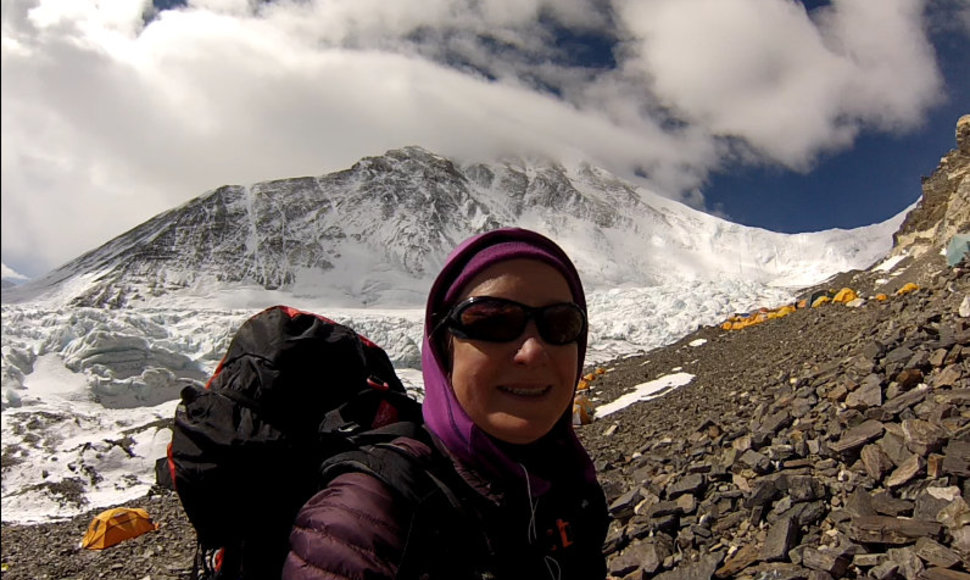It was an unbelievable week above 6,000 meters! When we arrived at the Advanced Base Camp (ABC) from the base camp on April 23, it was hard to believe we were just at the footsteps of Chomolungma. It was a really long and hard walk from the base camp. I arrived after some 6 hours of walking. I was exhausted. I knew it would be a difficult walk but I didn’t expected I would arrive so exhausted.
Already the trek to the base camp was hard and I arrived there with my face sun-burnt. The best part of the trek to the ABC was when I saw Sange Sherpa sand Tarki Sherpa walking towards me with a thermos of warm juice. The disappointment came a little later, when they said that there were still two hours to go to the ABC. The last hour was the hardest of all - very hot, sun beating, heavy backpack, etc. When I finally saw the ABC from a distance, I was so thrilled, even though it took a good 30-minute walk to reach it.
I could say now I climbed Chomolungma! Yes, I went close to 7,000 meters on our first rotation to the North Col. It was unbelievable! It was hard but liberating. When I saw the North Col from the distance, I had an uneasy feeling - how was I going to climb this vertical ice wall? However, once you are on the wall, the reality is different – the climb is not as steep as it looks. By no means was it easier than I thought - it was really hard. It was just that I was feeling strong and motivated and I wanted to keep climbing.
My cough is still strong but not worse then in my previous expeditions. It is strange that when I climb, I cough less, and when I am back after the climb, my cough is much better – as if the wind takes it away. Many people are coughing here, almost everyone. It is called Khumbu cough, from dry and cold air. It is normal to have it as long as it doesn’t develop into a chest infection. Last year, the cough and later the infection cost Margaret her summit bid — she had to turn away at the third step.
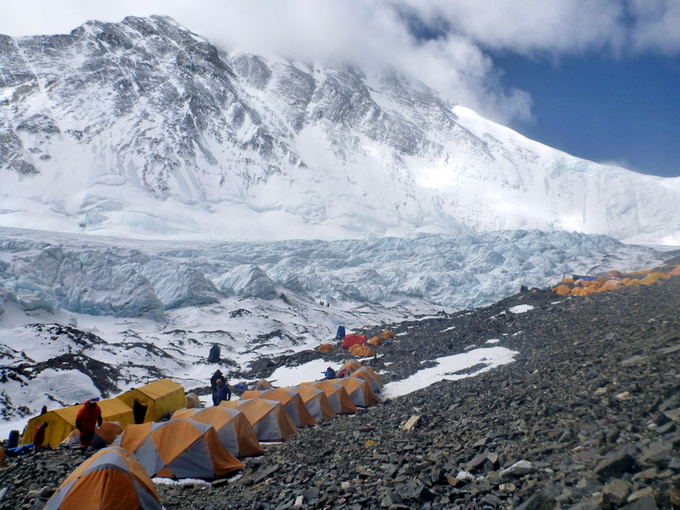 |
| Editos Nichols asmeninio archyvo nuotr./The ABC |
We got up at 5 AM that morning, had breakfast at 5:30, packed water and snacks and were on the way to the Col. The day looked promising – the winds were not too strong and it was a nice and relatively warm morning. I was only wearing my base layer and goretex jacket and wasn’t cold at all. At the beginning of the trek, we went up through stone and rock up to to the crampon point were we put on crampons before crossing a snow plateau towards the North Col wall.
The walk was not difficult, however, it made me feel a little nervous, seeing that huge wall right in front of me. I passed several group members and decided not to stop and rest but continue on and climb up the wall. It was good to get ahead of the huge group of Chinese and some other climbers.
The first section was quite steep, ice wall, pulling up on my jumar. At the end of that section, I had to take a few minutes to regain my breath.
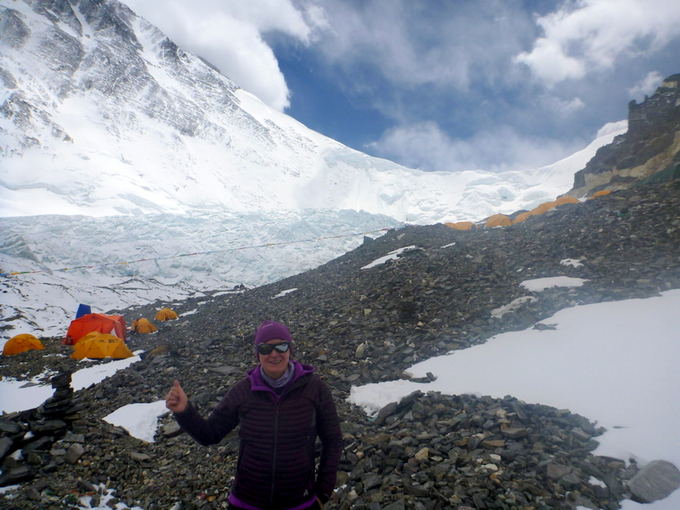 |
| Editos Nichols asmeninio archyvo nuotr./Edita in the ABC |
I didn’t want to wait for too long, so I just kept going section after section. Several hours into climbing, the wind became stronger and colder. I put my warmer gloves on and continued. I felf strong and focused. I don’t have a personal Sherpa, so I climb alone, taking my own pace. I like it that way.
However, the wind continued to blow stronger and stronger. I even had to stop several times and stay low until it passed. The higher I climbed, the more dangerous it became to do so, especially with wind blowing so hard — there were several crevasses with aluminum ladders over. I saw one group member heading down. He said he reached his goal he wanted for today and now is heading down. I wasn’t too cold and I still had enough energy and motivation to continue on. I was curious to see how far I could go today.
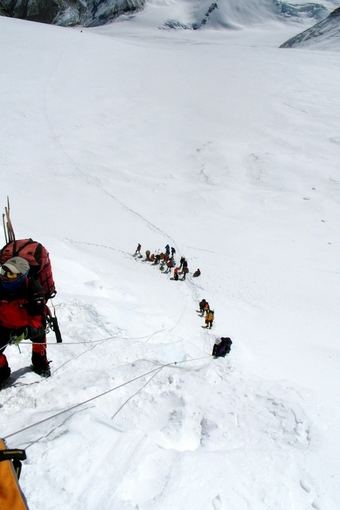 |
| Editos Nichols asmeninio archyvo nuotr./The North Col wall |
So a group member turning back didn’t discourage me. However, I wasn’t feeling too safe to continue alone. I waited for some time and saw two figures emerging from below. It was Margaret and her Sherpa Ang Gelu. I let them pass and joined behind them. Margaret also seemed to be motivated and determined to continue as high as possible. It was a wise decision.
The wind was getting stronger and stronger and there were more of these ladders. I won’t be able to thank Margaret and Ang Gelu enough for extending their hands toward me when I had to cross a difficult section – walking over the ladder. It takes all your energy to put one foot in front of other when you climb in this altitude. To help someone is very hard, it exhausts you instantly. These are true friends and selfless people who do not leave you behind in this difficult environment. These are the priceless moments.
Finally, we ran into Phil and a couple of other group members who where coming down. I still had enough energy to climb on (the top of the Col was closer than 200 meters away) but Phil encouraged us to turn around as the wind was really strong by then. Climbing further in this cold wind could mean risking getting frostbites before even going on to the summit push. The goal today was to climb as high as we could without taking any risks. We felt we even exceeded that goal and it was the time to go down to the ABC.
Going down the Col was quite a drama – a huge group of Chinese climbers and some others where sill coming up on the fixed line. Descending off the Col was quite difficult – very steep wall and a group of coming up climbers. There was not even a chance of using a figure 8 or any other repelling device. It was a steep, slippery, descent with deep snow and ice. Several people slipped right in front of me.
The only security you had was your safety sling that you clip to the fixed line no matter what. The slope is steep, but you don’t have enough rope (fixed rope is too tight and plus people clipping in both ways) to use a repelling device, but just a simple arm wrap technique. I’ve been using a different technique (including arm wrap) before but this one looked scary - just holding onto the fixed rope with one hand behind and another hand in front and the security sling in the middle. It is actually anything but a “technique” - “no technique” is more accurate - but that’s the way you can safely and quickly descent the Col. Using Phil’s technique, I was still extra careful until I got down the last section of the wall.
I was back at the ABC just for lunch. I was screaming with joy – yes, I did it! I climbed Chomolungma! I came in such a close contact with the mountain Goddess! Chomolungma was kind to me – all my earlier fears about climbing the North Col were dissolved.
However, deeply inside I know this was still an easy part of climbing Chomolungma. The real test will come in a week or two weeks, during our summit push.
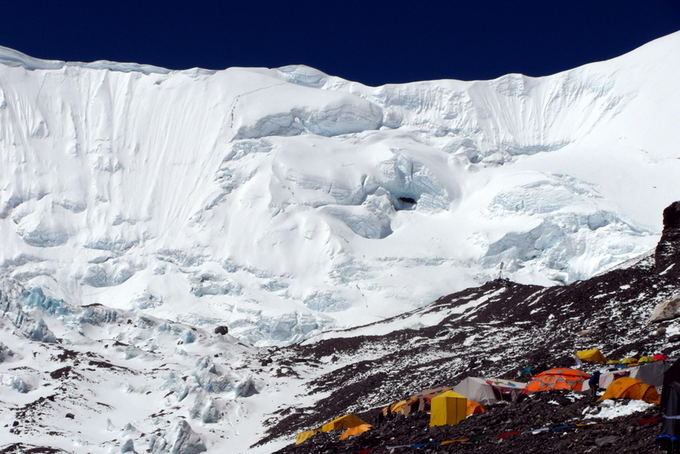 |
| Editos Nichols asmeninio archyvo nuotr./The North Col |
Our original plan was to stay at the ABC for a week and do two rotations to the Col if the weather permitted. However, a day after we came back from our first rotation, the jet stream came over Everest a few days earlier than predicted. We waited a couple of extra days, hoping for a change in weather, but winds got stronger and stronger with each passing day and hour.
Phil has made a decision and announced that the North Col rotation is now completed. Even though some people in the group weren’t able to tag the Col for various reasons, the acclimatization at the ABC level was successful. Everyone stayed on and have overcome any high altitude-related symptoms. Everyone now deserves to go down and rest at the BC.
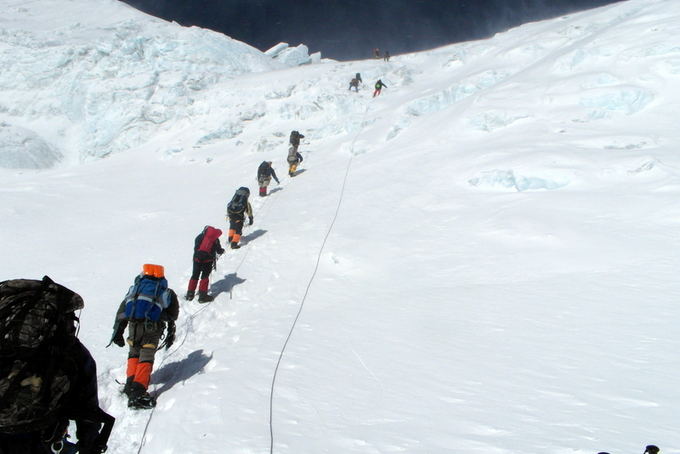 |
| Editos Nichols asmeninio archyvo nuotr./The North Col wall |
It is so nice being back at the BC. The weather warmed up here noticeably, in just a week. I got a bucket with hot water and could finally wash my hair and shower. After a week at the rugged ABC, life at the BC seems like a paradise. Our cook Da Pasang made a delicious meal last night – steak sizzler, accompanied with red wine. The ABC is really a no man’s land, especially now, with winds hollering all night long, where the only comfortable place is your sleeping bag and your down suit.
Besides a spectacular views of Chomolungma, there is nothing else there for a human being to make her stay longer than necessary for acclimatization. Your body at that level starts dying out. It’s not acclimatization anymore, it’s just an adjustment to that altitude.
The plan is now to wait until the ropes are fixed up to the summit and for that ‘magic’ weather window to open for the summit push. Our Sherpas will have to carry loads with tents and oxygen from the Col to camp two and three. This can take from five days up to two weeks. My guess is about 10 days. So the waiting game begins now.
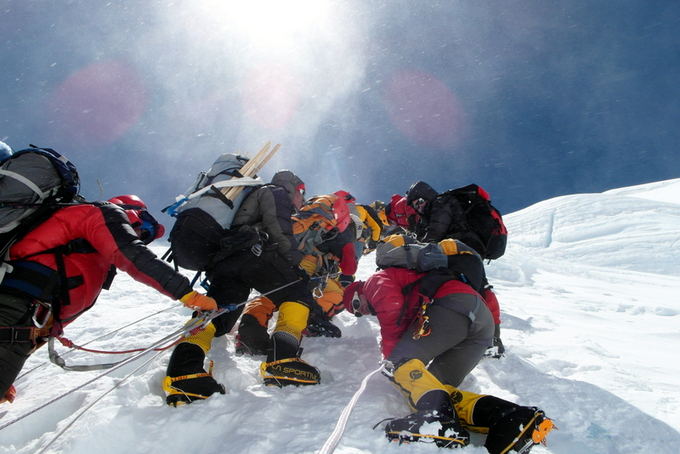 |
| Editos Nichols asmeninio archyvo nuotr./Descending the North Col |
Climb dedicated to poor African region
Edita dedicates her ambitious quest to a campaign called “Everest for Sahel 2013”. She says she wants to draw attention to a serious food crisis that affects millions of families in the region and also collect some funds to help.
“When I was working in Niger, the media initially paid much attention to the food crisis. But later the interest abated. And people there are suffering not just famine. An armed conflict is currently raging in Mali,” she says.
Sahel is a zone in west Africa stretching across eight states. The food crises was triggered by crop failure in 2011 due to adverse natural conditions. As stocks went down, food prices spiraled up. Many families cannot afford it and risk starving to death.
Edita saw suffering people with her own eyes and resolved to try and help them – she thought she could draw attention to their problems and maybe even collect some money for relief.
“To finance the Everest trip, I spend my own hard-earned money and borrowed funds. I finance all my expeditions myself. This trip, too, is entirely covered by my personal funds and those of my sponsors (this time, though, sponsors cover only 3 percent of the expense, - 15min). Meanwhile all the money donated or collected during the expedition, and intended for the people of Sahel, does not go to my own account but rather to one of the World Food Programme,” Edita points out.
You can support Edita's Everest quest. To learn more about how you can contribute, press here.
To support Edita directly, press here.
